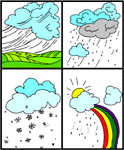|
|
|
SCIENCE STANDARDS 1. Students should recognize that water can be a
solid, gas, or liquid. WATER Water is a transparent, odorless, tasteless liquid composed of the elements hydrogen and oxygen. It is a very good solvent, meaning that many substances can dissolve in it easily. Water is important to our lives, and without it we could not live. In fact, there are no living creatures that can live without water. Water most probably originated on this planet as gases were being emitted from volcanoes. The Earth's atmosphere captured this water and has continuously recycled it throughout time, in what is called the water cycle. Water evaporates and forms clouds; the clouds provide rain and snow, which is collected in rivers, lakes, underground reservoirs, and oceans that are the source for further evaporation. Water is that perfect substance for the water cycle, because it has a high boiling point and a low freezing point. I. LOWER PRIMARY - PROPERTIES OF WATER Students need to learn the properties of water by experimenting with water as a solid, liquid, and gas. Students need to evaluate and identify the 3 states of matter as they pertain to water. The students should learn about properties of water such as surface tension, boiling point, freezing point, etc. II. UPPER PRIMARY - WATER AS A CHEMICAL AND COMMODITY The complexity of water is ideal for students to further investigate chemistry. The students need to further explore surface tension, capillary action, density, and other properties of water. They will also investigate the importance of ground water and surface water. OCEANS Water erodes the land, which causes rocks to be broken up and as these rocks are being broken up, minerals are added to the water creating "salt water." The oceans have always been a symbol of fun and sun and children love to play in the sand and watch the waves hit upon the shores. Students need to understand how large the oceans are, the impact the oceans have on the weather, and the properties of salt water compared with those of fresh water. It was the oceans that provided easy transportation for the early explorers, food for early people, and salt to preserve food. I. LOWER PRIMARY - PROPERTIES OF SALT WATER Students learn the properties of salt water. They will learn to evaluate the differences between salt water and fresh water. They will learn how to distinguish different types of water by evaluating their densities and tastes. The students will also look at the differences between dirty and polluted water and compare those differences with fresh and salt water. II. UPPER PRIMARY - OCEANS AS A BASIN FILLED WITH WATER Oceans are a complex feature of the earth's surface. The water that fills up the oceans has distinct properties; the ocean floor is a land covered by water and the water that fills the basins of this land moves in such a pattern that affects the rest of the planet. Students will learn some properties of salt water and will look at the ocean bottom and learn about Coriolis motion. ATMOSPHERE The atmosphere is divided into five layers: the troposphere, stratosphere, mesosphere, thermosphere, and exosphere. These layers control the weather. Atmosphere for elementary students introduces the composition of air, how the changing states of matter control weather formation, how air moves and why the atmosphere is so important to humans. The troposphere is where most of the weather occurs, and hence most readily understandable by students. Air heated by the sun, rises and is replaced by colder air in a process called convection. These currents create winds which move clouds that were created by the evaporation of surface waters. I. LOWER PRIMARY - PHYSICAL COMPONENTS OF THE ATMOSPHERE The atmosphere is composed of different types of gases called air. Students will demonstrate the movement of air as well as discover what air is made of. They will analyze different types of clouds as well as discover that air exerts enormous pressures on objects. II. UPPER PRIMARY - PHYSICS OF THE ATMOSPHERE The atmosphere has many different layers. Students will learn to compare and contrast the differences among the various layers. The students will experiment with hot and cold air and see how they can produce convection currents. They will investigate further how winds move particles throughout the atmosphere. WEATHER Weather is all around us. Children learn early that their lifestyle is dependant upon how the weather changes. One of a student's first observations of the real world outside his home depends on which clothes will be worn in order to play outside. Children record whether the weather is hot, cold, warm, cool, wet, or dry, but usually do not realize why the weather changes. There are several key concepts that need to be developed in studying the weather. Long term weather gives a region its climate. Weather is controlled by the solar heating of our planet. The spinning of our planet affects how warm and cold masses are moved by the wind. Seasons are caused by the tilt of the Earth's axis. I. LOWER PRIMARY - TYPES OF WEATHER Students learn to discover the different types of
weather not only in their community, but around the world. Learning how
to analyze different types of weather measuring equipment is important.
Students become familiar with how topography influences weather and how
water can be derived from air. Students learn the difference between high and low pressure. They analyze weather and satellite photos to see how they are similar and dissimilar. Students learn how local weather is generated and are able to explain the phenomena. OVERVIEW OF KINDERGARTEN WATER WEEK 1. OCEANS WEEK 2. ATMOSPHERE WEEK 3. WEATHER WEEK 4. |

 Water
Cycle
Water
Cycle